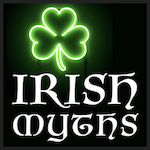Irish Myths is reader-supported. When you buy through links on our site, we may earn a small affiliate commission.
At first glance, the reason why we decorate with black and orange on Halloween seems obvious:
Black is scary and orange is the color of pumpkins. Hence, they became Halloween’s go-to color combo.
Put a black and orange bow on it; this mystery has been solved.
Except…that’s not it. That’s not it at all.
Pssst. I made a video segment that answers this question if you’re more of an audio-visual learner. (Text continues below.)
In order to understand why black and orange became the colors of Halloween, we need to look back to Halloween’s Celtic progenitor, Samhain.
Let’s tackle black first.
How did the color black become associated with Halloween?
One could make that argument that black is inherently scary because it represents the absence of color, the absence of light. Scientifically speaking, black isn’t a color at all—it’s what the eye perceives when confronted with an object that can absorb all of the colors of the visible spectrum.
For the ancient Celts, the color (or non-color?) black had a very specific connotation: it represented mourning and death. And what is Samhain if not a celebration of death?
The festival is centered around the dead who have passed on to the Celtic Otherworld (but who might make an appearance on the evening of October 31st) as well as the figurative death of the sun as winter approaches. To quote Whiskey Stevens, author of Rise of the Witch:
Black is a representation of the dark months that come with winter.
source: “What Are the Halloween Colors and What Do They Mean?” Reader’s Digest
How did the color orange become associated with Halloween?
It’s gotta be the pumpkins, right?
Making jack-o’-lanterns, after all, has been a Samhain tradition for centuries.
But remember: pumpkins originated in the Americas and were not available to ancient Samhain revelers—despite (unsubstantiated) claims that the ancient Celts crossed the Atlantic before the Vikings.
No, the ancient Celts originally used root vegetables—turnips in particular—for making jack-o’-lanterns. Pumpkin-carving came later. And by then, orange had already been well-established as a color of Halloween.
What gives?
Here’s a clue: go rub two sticks together. Bonus points if those sticks have a few fall leaves attached to them.
Allow me to be less cryptic:
It’s likely that orange represents the ceremonial Samhain fires lit by druids on the evening of October 31st.
As I explain in my article on the history of Halloween pumpkin-carving, the coals from those community fires would be transported via jack-o’-lantern and used to reignite the hearths in people’s homes that had been left to burn out.
Of course, there’s also the prevalence of the color orange in autumn leaves, which may have reinforced the idea of orange being a Samhain color. As Stevens explains:
Orange is representative of the fire that burns during the festival of Samhain and during the winter months. It also corresponds to the leaves that have changed color and of the harvest itself.
source: “What Are the Halloween Colors and What Do They Mean?” Reader’s Digest
Editor’s note: this article is an excerpt from “The Celtic History Behind Our Favorite Halloween Traditions: 6 Samhain Rituals That Refuse to Die.
Want to learn the full story of Samhain? Check out…
Samhain in Your Pocket (Celtic Pocket Guides 2)
Perhaps the most important holiday on the ancient Celtic calendar, Samhain marks the end of summer and the beginning of a new pastoral year. It is a liminal time—a time when the forces of light and darkness, warmth and cold, growth and blight, are in conflict. A time when the barrier between the land of the living and the land of the dead is at its thinnest. A time when all manner of spirits and demons are wont to cross over from the Celtic Otherworld. Learn more…
Want to learn about the darker side of Irish mythology? Check out…
Irish Monsters in Your Pocket (Celtic Pocket Guides 3)
In the Ireland of myth and legend, “spooky season” is every season. Spirits roam the countryside, hovering above the bogs. Werewolves lope through forests under full moons. Dragons lurk beneath the waves. Granted, there’s no denying that Samhain (Halloween’s Celtic predecessor) tends to bring out some of the island’s biggest, baddest monsters. Prepare yourself for (educational) encounters with Irish cryptids, demons, ghouls, goblins, and other supernatural beings. Learn more…
Neon Druid: An Anthology of Urban Celtic Fantasy
“A thrilling romp through pubs, mythology, and alleyways. NEON DRUID is such a fun, pulpy anthology of stories that embody Celtic fantasy and myth,” (Pyles of Books). Cross over into a world where the mischievous gods, goddesses, monsters, and heroes of Celtic mythology live among us, intermingling with unsuspecting mortals and stirring up mayhem in cities and towns on both sides of the Atlantic, from Limerick and Edinburgh to Montreal and Boston. Learn more…
More the listenin’ type?
I recommend the audiobook Celtic Mythology: Tales of Gods, Goddesses, and Heroes by Philip Freeman (narrated by Gerard Doyle). Use my link to get 3 free months of Audible Premium Plus and you can listen to the full 7.5-hour audiobook for free.





